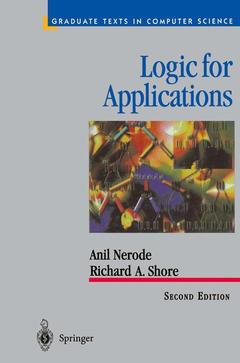Description
Logic for Applications (2nd Ed., 2nd ed. 1997)
Texts in Computer Science Series
Language: English
Subject for Logic for Applications:
Keywords
Algorithms; Automat; Syntax; automation; cardinality; cardinals; computability; computer; forcing; predicate logic; programming; proving; semantics; set theory; theorem proving
Publication date: 09-2012
456 p. · 15.5x23.5 cm · Paperback
456 p. · 15.5x23.5 cm · Paperback
Description
/li>Contents
/li>
In writing this book, our goal was to produce a text suitable for a first course in mathematical logic more attuned than the traditional textbooks to the re cent dramatic growth in the applications oflogic to computer science. Thus, our choice oftopics has been heavily influenced by such applications. Of course, we cover the basic traditional topics: syntax, semantics, soundnes5, completeness and compactness as well as a few more advanced results such as the theorems of Skolem-Lowenheim and Herbrand. Much ofour book, however, deals with other less traditional topics. Resolution theorem proving plays a major role in our treatment of logic especially in its application to Logic Programming and PRO LOG. We deal extensively with the mathematical foundations ofall three ofthese subjects. In addition, we include two chapters on nonclassical logics - modal and intuitionistic - that are becoming increasingly important in computer sci ence. We develop the basic material on the syntax and semantics (via Kripke frames) for each of these logics. In both cases, our approach to formal proofs, soundness and completeness uses modifications of the same tableau method in troduced for classical logic. We indicate how it can easily be adapted to various other special types of modal logics. A number of more advanced topics (includ ing nonmonotonic logic) are also briefly introduced both in the nonclassical logic chapters and in the material on Logic Programming and PROLOG.
I Propositional Logic.- 1 Orders and Trees.- 2 Propositions, Connectives and Truth Tables.- 3 Truth Assignments and Valuations.- 4 Tableau Proofs in Propositional Calculus.- 5 Soundness and Completeness of Tableau Proofs.- 6 Deductions from Premises and Compactness.- 7 An Axiomatic Approach*.- 8 Resolution.- 9 Refining Resolution.- 10 Linear Resolution, Horn Clauses and PROLOG.- II Predicate Logic.- 1 Predicates and Quantifiers.- 2 The Language: Terms and Formulas.- 3 Formation Trees, Structures and Lists.- 4 Semantics: Meaning and Truth.- 5 Interpretations of PROLOG Programs.- 6 Proofs: Complete Systematic Tableaux.- 7 Soundness and Completeness of Tableau Proofs.- 8 An Axiomatic Approach*.- 9 Prenex Normal Form and Skolemization.- 10 Herbrand’s Theorem.- 11 Unification.- 12 The Unification Algorithm.- 13 Resolution.- 14 Refining Resolution: Linear Resolution.- III PROLOG.- 1 SLD-Resolution.- 2 Implementations: Searching and Backtracking.- 3 Controlling the Implementation: Cut.- 4 Termination Conditions for PROLOG Programs.- 5 Equality.- 6 Negation as Failure.- 7 Negation and Nonmonotonic Logic.- 8 Computability and Undecidability.- IV Modal Logic.- 1 Possibility and Necessity; Knowledge or Belief.- 2 Frames and Forcing.- 3 Modal Tableaux.- 4 Soundness and Completeness.- 5 Modal Axioms and Special Accessibility Relations.- 6 An Axiomatic Approach*.- V Intuitionistic Logic.- 1 Intuitionism and Constructivism.- 2 Frames and Forcing.- 3 Intuitionistic Tableaux.- 4 Soundness and Completeness.- 5 Decidability and Undecidability.- 6 A Comparative Guide.- VI Elements of Set Theory.- 1 Some Basic Axioms of Set Theory.- 2 Boole’s Algebra of Sets.- 3 Relations, Functions and the Power Set Axiom.- 4 The Natural Numbers, Arithmetic and Infinity.- 5 Replacement, Choice andFoundation.- 6 Zermelo-Fraenkel Set Theory in Predicate Logic.- 7 Cardinality: Finite and Countable.- 8 Ordinal Numbers.- 9 Ordinal Arithmetic and Transfinite Induction.- 10 Transfinite Recursion, Choice and the Ranked Universe.- 11 Cardinals and Cardinal Arithmetic.- Appendix A: An Historical Overview.- 1 Calculus.- 2 Logic.- 3 Leibniz’s Dream.- 4 Nineteenth Century Logic.- 5 Nineteenth Century Foundations of Mathematics.- 6 Twentieth Century Foundations of Mathematics.- 7 Early Twentieth Century Logic.- 8 Deduction and Computation.- 9 Recent Automation of Logic and PROLOG.- 10 The Future.- Appendix B: A Genealogical Database.- Index of Symbols.- Index of Terms.
© 2024 LAVOISIER S.A.S.




